Jinda Lu
AdaViP: Aligning Multi-modal LLMs via Adaptive Vision-enhanced Preference Optimization
Apr 22, 2025Abstract:Preference alignment through Direct Preference Optimization (DPO) has demonstrated significant effectiveness in aligning multimodal large language models (MLLMs) with human preferences. However, existing methods focus primarily on language preferences while neglecting the critical visual context. In this paper, we propose an Adaptive Vision-enhanced Preference optimization (AdaViP) that addresses these limitations through two key innovations: (1) vision-based preference pair construction, which integrates multiple visual foundation models to strategically remove key visual elements from the image, enhancing MLLMs' sensitivity to visual details; and (2) adaptive preference optimization that dynamically balances vision- and language-based preferences for more accurate alignment. Extensive evaluations across different benchmarks demonstrate our effectiveness. Notably, our AdaViP-7B achieves 93.7% and 96.4% reductions in response-level and mentioned-level hallucination respectively on the Object HalBench, significantly outperforming current state-of-the-art methods.
Aligning Multimodal LLM with Human Preference: A Survey
Mar 18, 2025Abstract:Large language models (LLMs) can handle a wide variety of general tasks with simple prompts, without the need for task-specific training. Multimodal Large Language Models (MLLMs), built upon LLMs, have demonstrated impressive potential in tackling complex tasks involving visual, auditory, and textual data. However, critical issues related to truthfulness, safety, o1-like reasoning, and alignment with human preference remain insufficiently addressed. This gap has spurred the emergence of various alignment algorithms, each targeting different application scenarios and optimization goals. Recent studies have shown that alignment algorithms are a powerful approach to resolving the aforementioned challenges. In this paper, we aim to provide a comprehensive and systematic review of alignment algorithms for MLLMs. Specifically, we explore four key aspects: (1) the application scenarios covered by alignment algorithms, including general image understanding, multi-image, video, and audio, and extended multimodal applications; (2) the core factors in constructing alignment datasets, including data sources, model responses, and preference annotations; (3) the benchmarks used to evaluate alignment algorithms; and (4) a discussion of potential future directions for the development of alignment algorithms. This work seeks to help researchers organize current advancements in the field and inspire better alignment methods. The project page of this paper is available at https://github.com/BradyFU/Awesome-Multimodal-Large-Language-Models/tree/Alignment.
Accelerating Diffusion Transformer via Gradient-Optimized Cache
Mar 07, 2025



Abstract:Feature caching has emerged as an effective strategy to accelerate diffusion transformer (DiT) sampling through temporal feature reuse. It is a challenging problem since (1) Progressive error accumulation from cached blocks significantly degrades generation quality, particularly when over 50\% of blocks are cached; (2) Current error compensation approaches neglect dynamic perturbation patterns during the caching process, leading to suboptimal error correction. To solve these problems, we propose the Gradient-Optimized Cache (GOC) with two key innovations: (1) Cached Gradient Propagation: A gradient queue dynamically computes the gradient differences between cached and recomputed features. These gradients are weighted and propagated to subsequent steps, directly compensating for the approximation errors introduced by caching. (2) Inflection-Aware Optimization: Through statistical analysis of feature variation patterns, we identify critical inflection points where the denoising trajectory changes direction. By aligning gradient updates with these detected phases, we prevent conflicting gradient directions during error correction. Extensive evaluations on ImageNet demonstrate GOC's superior trade-off between efficiency and quality. With 50\% cached blocks, GOC achieves IS 216.28 (26.3\% higher) and FID 3.907 (43\% lower) compared to baseline DiT, while maintaining identical computational costs. These improvements persist across various cache ratios, demonstrating robust adaptability to different acceleration requirements.
DAMO: Data- and Model-aware Alignment of Multi-modal LLMs
Feb 04, 2025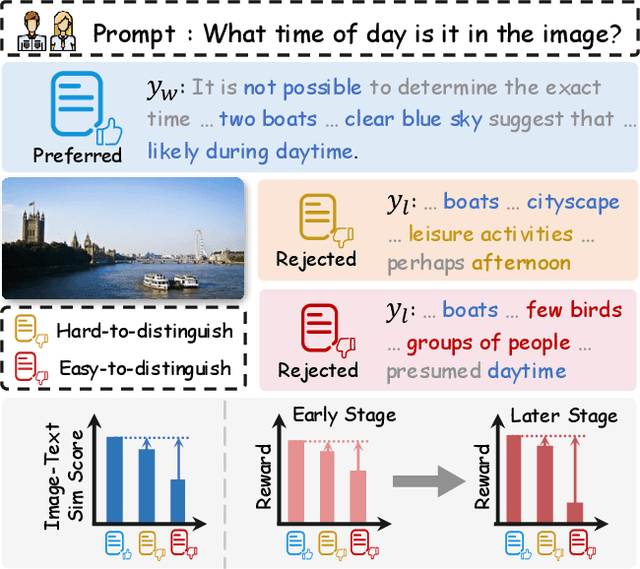
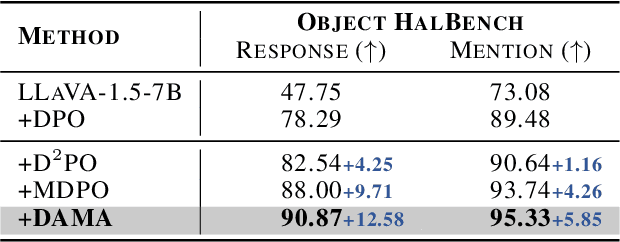


Abstract:Direct Preference Optimization (DPO) has shown effectiveness in aligning multi-modal large language models (MLLM) with human preferences. However, existing methods exhibit an imbalanced responsiveness to the data of varying hardness, tending to overfit on the easy-to-distinguish data while underfitting on the hard-to-distinguish data. In this paper, we propose Data- and Model-aware DPO (DAMO) to dynamically adjust the optimization process from two key aspects: (1) a data-aware strategy that incorporates data hardness, and (2) a model-aware strategy that integrates real-time model responses. By combining the two strategies, DAMO enables the model to effectively adapt to data with varying levels of hardness. Extensive experiments on five benchmarks demonstrate that DAMO not only significantly enhances the trustworthiness, but also improves the effectiveness over general tasks. For instance, on the Object HalBench, our DAMO-7B reduces response-level and mentioned-level hallucination by 90.0% and 95.3%, respectively, surpassing the performance of GPT-4V.
Accelerating Diffusion Transformer via Error-Optimized Cache
Jan 31, 2025



Abstract:Diffusion Transformer (DiT) is a crucial method for content generation. However, it needs a lot of time to sample. Many studies have attempted to use caching to reduce the time consumption of sampling. Existing caching methods accelerate generation by reusing DiT features from the previous time step and skipping calculations in the next, but they tend to locate and cache low-error modules without focusing on reducing caching-induced errors, resulting in a sharp decline in generated content quality when increasing caching intensity. To solve this problem, we propose the Error-Optimized Cache (EOC). This method introduces three key improvements: (1) Prior knowledge extraction: Extract and process the caching differences; (2) A judgment method for cache optimization: Determine whether certain caching steps need to be optimized; (3) Cache optimization: reduce caching errors. Experiments show that this algorithm significantly reduces the error accumulation caused by caching (especially over-caching). On the ImageNet dataset, without significantly increasing the computational burden, this method improves the quality of the generated images under the over-caching, rule-based, and training-based methods. Specifically, the Fr\'echet Inception Distance (FID) values are improved as follows: from 6.857 to 5.821, from 3.870 to 3.692 and form 3.539 to 3.451 respectively.
Unified Parameter-Efficient Unlearning for LLMs
Nov 30, 2024



Abstract:The advent of Large Language Models (LLMs) has revolutionized natural language processing, enabling advanced understanding and reasoning capabilities across a variety of tasks. Fine-tuning these models for specific domains, particularly through Parameter-Efficient Fine-Tuning (PEFT) strategies like LoRA, has become a prevalent practice due to its efficiency. However, this raises significant privacy and security concerns, as models may inadvertently retain and disseminate sensitive or undesirable information. To address these issues, we introduce a novel instance-wise unlearning framework, LLMEraser, which systematically categorizes unlearning tasks and applies precise parameter adjustments using influence functions. Unlike traditional unlearning techniques that are often limited in scope and require extensive retraining, LLMEraser is designed to handle a broad spectrum of unlearning tasks without compromising model performance. Extensive experiments on benchmark datasets demonstrate that LLMEraser excels in efficiently managing various unlearning scenarios while maintaining the overall integrity and efficacy of the models.
DiffGAD: A Diffusion-based Unsupervised Graph Anomaly Detector
Oct 09, 2024



Abstract:Graph Anomaly Detection (GAD) is crucial for identifying abnormal entities within networks, garnering significant attention across various fields. Traditional unsupervised methods, which decode encoded latent representations of unlabeled data with a reconstruction focus, often fail to capture critical discriminative content, leading to suboptimal anomaly detection. To address these challenges, we present a Diffusion-based Graph Anomaly Detector (DiffGAD). At the heart of DiffGAD is a novel latent space learning paradigm, meticulously designed to enhance its proficiency by guiding it with discriminative content. This innovative approach leverages diffusion sampling to infuse the latent space with discriminative content and introduces a content-preservation mechanism that retains valuable information across different scales, significantly improving its adeptness at identifying anomalies with limited time and space complexity. Our comprehensive evaluation of DiffGAD, conducted on six real-world and large-scale datasets with various metrics, demonstrated its exceptional performance.
Rethinking Visual Content Refinement in Low-Shot CLIP Adaptation
Jul 19, 2024



Abstract:Recent adaptations can boost the low-shot capability of Contrastive Vision-Language Pre-training (CLIP) by effectively facilitating knowledge transfer. However, these adaptation methods are usually operated on the global view of an input image, and thus biased perception of partial local details of the image. To solve this problem, we propose a Visual Content Refinement (VCR) before the adaptation calculation during the test stage. Specifically, we first decompose the test image into different scales to shift the feature extractor's attention to the details of the image. Then, we select the image view with the max prediction margin in each scale to filter out the noisy image views, where the prediction margins are calculated from the pre-trained CLIP model. Finally, we merge the content of the aforementioned selected image views based on their scales to construct a new robust representation. Thus, the merged content can be directly used to help the adapter focus on both global and local parts without any extra training parameters. We apply our method to 3 popular low-shot benchmark tasks with 13 datasets and achieve a significant improvement over state-of-the-art methods. For example, compared to the baseline (Tip-Adapter) on the few-shot classification task, our method achieves about 2\% average improvement for both training-free and training-need settings.
Boosting Few-Shot Learning via Attentive Feature Regularization
Mar 23, 2024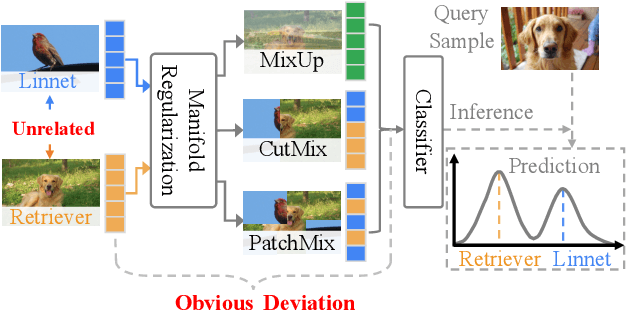
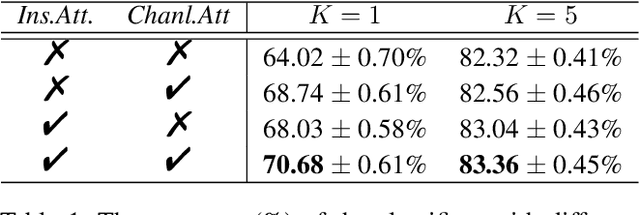

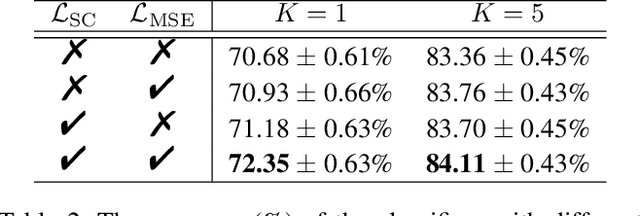
Abstract:Few-shot learning (FSL) based on manifold regularization aims to improve the recognition capacity of novel objects with limited training samples by mixing two samples from different categories with a blending factor. However, this mixing operation weakens the feature representation due to the linear interpolation and the overlooking of the importance of specific channels. To solve these issues, this paper proposes attentive feature regularization (AFR) which aims to improve the feature representativeness and discriminability. In our approach, we first calculate the relations between different categories of semantic labels to pick out the related features used for regularization. Then, we design two attention-based calculations at both the instance and channel levels. These calculations enable the regularization procedure to focus on two crucial aspects: the feature complementarity through adaptive interpolation in related categories and the emphasis on specific feature channels. Finally, we combine these regularization strategies to significantly improve the classifier performance. Empirical studies on several popular FSL benchmarks demonstrate the effectiveness of AFR, which improves the recognition accuracy of novel categories without the need to retrain any feature extractor, especially in the 1-shot setting. Furthermore, the proposed AFR can seamlessly integrate into other FSL methods to improve classification performance.
 Add to Chrome
Add to Chrome Add to Firefox
Add to Firefox Add to Edge
Add to Edge